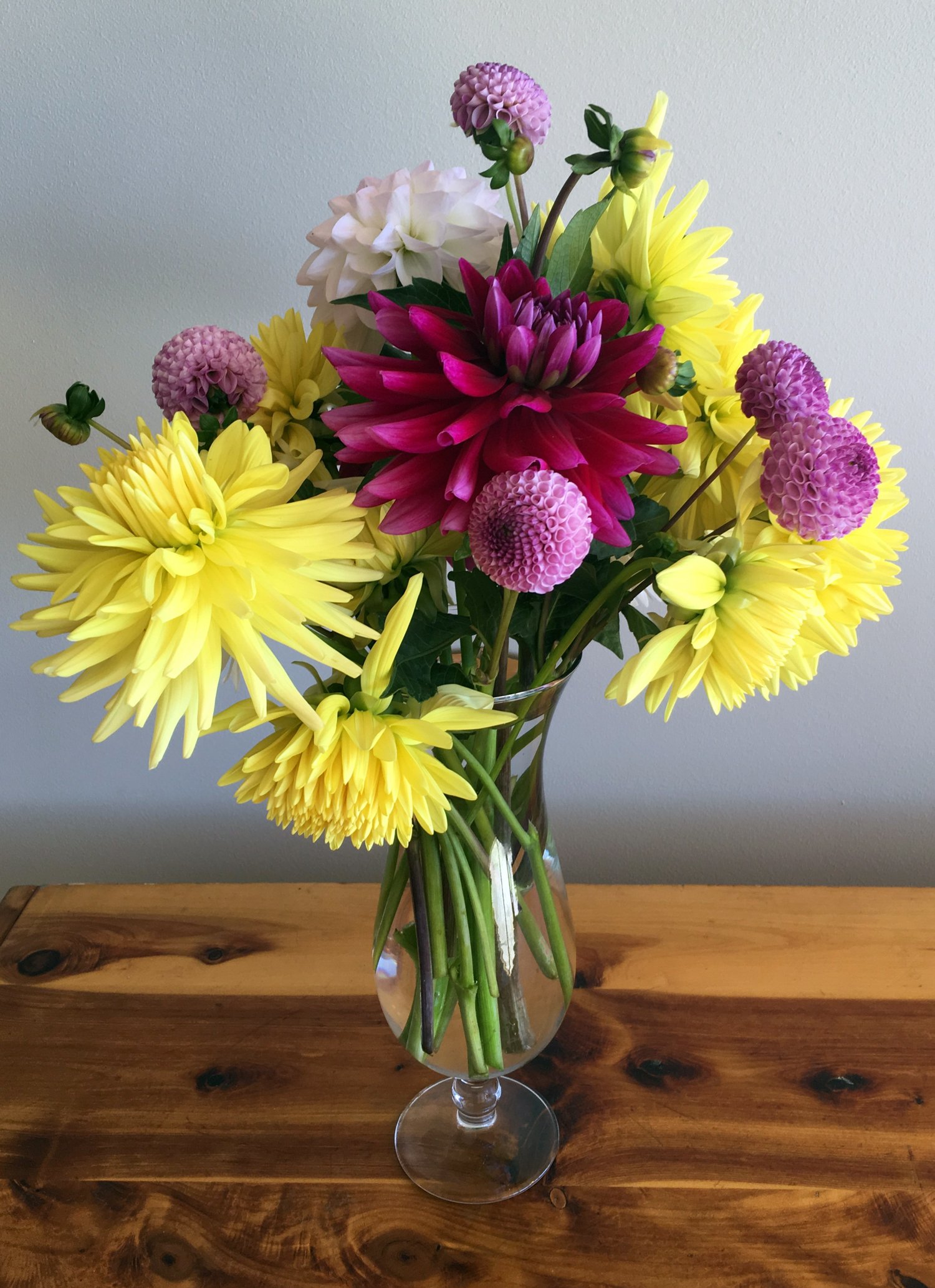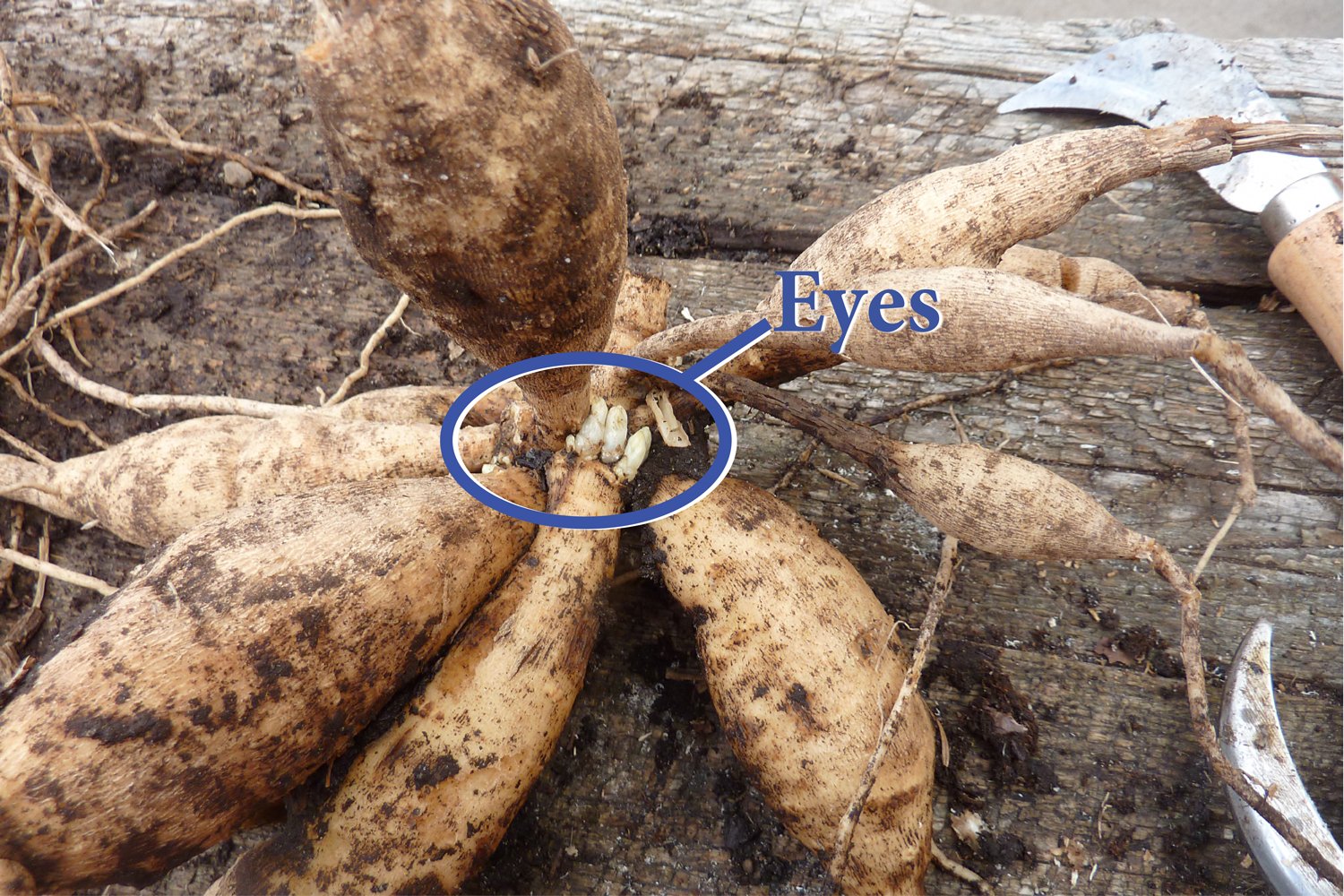Dahlias reign supreme in the late summer garden. They are vigorous growers and reliable bloomers; they add luster to the landscape with their foliage in various shades of green and blooms that range from petite pom-poms to flowers the size of dinner plates, in an entire rainbow of colors; they are marvelous in a vase.
Dahlias die back each year as autumn advances, but, with the proper care, the tuberous root system can live on to produce a stunning display year after year. The advice in this post is based on many years of growing dahlias in a low-lying area of Seattle with relatively moderate winter temperatures and excellent drainage. It may differ from other advice available.
If dahlia tubers freeze or get too soggy, they can rot. If this is a possibility in your garden due to a colder than average microclimate or poor drainage, tubers can be lifted and stored indoors for the winter. Otherwise, with normal winter temperatures and good drainage, tubers should survive in the ground reliably year after year in the PNW Seattle area.
Keeping Dahlia Tubers in the Ground Over the Winter
After a hard frost, when the dahlia foliage and stalks die back, cut the plant back to about 6 inches from the ground. Some growers prefer not to cut them back because the stems are hollow and cut stems can fill with water and potentially cause the tubers to rot. To prevent this from happening, cover the tubers well with a mound of mulch that will shed water such as a straw, leaves, or compost. In the spring, you can remove thick leaf or straw mulch; your dahlias will sprout through compost.
Dahlia plants after a frost
photo: Martha Stewart Blog
Straw mulch
photo: Love’n Fresh Flowers
Digging Dahlias to Store Over the Winter
There is always a chance we will have a particularly cold or wet winter and your tubers will get too soggy or freeze. If you want to be absolutely sure that your tubers survive, you may want to dig and divide them. Another reason to dig and divide is to increase your stock of tubers. One single tuber planted last spring can grow into 5-10 or more viable tubers for growing or sharing next spring!
Tubers and stalks get woody in storage, so it’s easier to cut through the stalks in the fall if you plan to store the tubers indoors for the winter. However, you can also dig and divide tubers in the spring.
Dig under the tuber clump with a spading fork, gently tipping the clump up to avoid damaging the necks of the tubers.
Wash the dirt off the clump with a spray nozzle, especially from the crevices where the tubers join the stalk because that is where the growing eyes are located, as pictured here.
Each tuber must have a growing eye to be viable and grow a new dahlia plant. Eyes may look like small white bumps and be difficult to see. Storing the tubers in a medium like moistened - but not saturated - wood shavings or bark, out of direct sun in 50-60 degree temperatures for a week or so may give the eyes a chance to start to swell so they are easier to see.
With a sharp knife or pruners, cut into the stalk vertically between the eyes, leaving each tuber with an eye attached. For large clumps with multiple stalks, divide the entire clump in half or quarters and then divide the tubers from each stalk. Trim and discard excess stalks. Some growers treat their tubers with a fungicide or bleach solution to prevent rot. I have not done this and do not have problems with tubers rotting.
Broken, bruised or damaged tubers, or tubers without visible eyes can be composted. If you are dividing your dahlias in the spring, you can try an interesting experiment: plant these iffy tubers up in a pot and see if they sprout; you just may be pleasantly surprised!
Store the tubers in a medium that retains moisture like sawdust or bark that is about as moist as a wrung-out sponge. They should be dry on the surface and not shriveled. A temperature of 40 degrees is ideal. Plastic bins or cardboard boxes lined with plastic will help maintain moisture. Check on them periodically to make sure they are moist but not soggy or shriveled.
When the soil and weather warm up in the spring and all danger of frost is past, it’s time to take the tubers out of storage for planting. Or, if you didn’t lift and divide them in the fall, you can do it in the spring. Look for another blog post on planting your tubers out in the garden when planting time comes around again.
If you have any questions about caring for dahlias, let us know in person, by email, or on social media with #heyswansons. We’d be happy to help!
Note: All photos by Denise Read unless otherwise noted.








